The polar expedition of the airship Italia in 1928 was to be a spectacular success. It turned out to be a series of failures that cost the lives of half the crew.
April 15, 1928, around 8:30 p.m. The airship Italia flying to the North Pole appeared in the sky over Katowice. Earlier that day, the crew lost their orientation and the machine was hovering over Silesia for several hours. But that was only the beginning of the tragic history of the machine, which was clearly haunted by bad luck.
Crazy Italy
Umberto Nobli's career could have ended quite differently if, after World War I, doctors had not declared him incapable of performing professional military service. In their opinion, the young engineer was too small and frail. Looking for an idea for himself, fascinated by the invention of Zeppelin, Nobile founded a company that built airships. In 1925, Roald Amundsen, a well-known Norwegian traveler, the first South Pole conqueror, wrote to him. The Norwegian wanted to buy an airship from Nobilly and fly it over the North Pole.
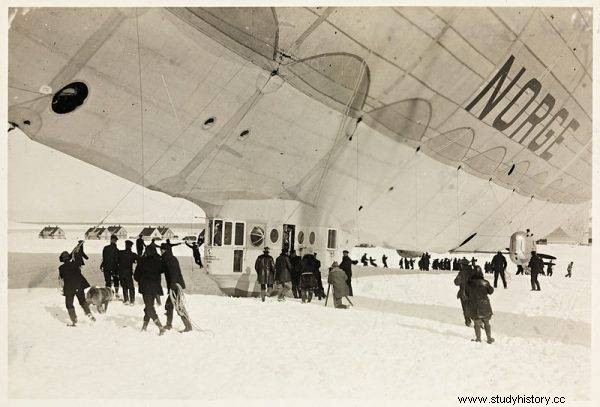
In 1926, aboard a machine called by Amundsen "Norge" (Norway), the crew commanded by Umberto Nobli himself reached their destination.
The offer has been accepted. In 1926, on board a machine called by Amundsen "Norge" (Norway), the crew, commanded by Umberto Nobli himself, reached their destination. Unfortunately, was not without conflicts. The combination of Nobli's Italian temperament and Amundsen's Scandinavian disposition turned out to be a truly explosive mixture.
There were many disputes on board, the main cause of which was the bravado and irresponsibility that the Italian pilot was accused of. The two gentlemen were also divided by Nobli's great ego. Although the airship officially belonged to the Kingdom of Norway, and the entire expedition was led by Amundsen, acting as the captain of Italy, he considered himself the most important person on board. Oil was added to the fire by the fact that Nobile decided to take… his dog on the journey.
Unlucky start
Two years later, encouraged by the worldwide success of the first expedition, Nobile decided to take the next step - an arctic expedition that ended with the landing of the airship on the Pole. The media hype around Italy (because that was the name he gave to the Nobile machine) started even before the start. The world followed the expedition with emotions comparable to those decades later caused by the first moon landing . Newspapers all over Europe wrote about General Nobile's expedition. The route was to lead from Italy, over central Europe, towards Norway and further to the North Pole.
On April 15 at 1:55 am, Italia took off from Milan airport with a crew of twenty. The problems started on the same day. Over the Sudetes, the airship fell into thick clouds and a terrible storm that damaged the radio and navigation devices. The machine lost its orientation and was hovering in a direction unknown to the crew.
Radio operators save Italy
On the same day, around 8.30 pm, the director of the Polish Radio in Katowice, Stefan Tymieniecki, received an unusual phone call. The policeman, who was completely disbelieving his own words, informed him that Italy was probably hovering over Katowice. Similarly, the inhabitants of the city were astonished in crowds to admire this unusual sight. After all, the airship's route was supposed to be completely different…
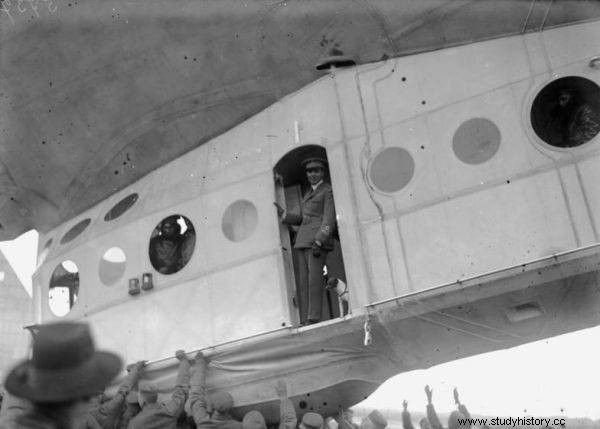
A few days later the radio management received official thanks from General Nobli himself for his help.
The Italian crew, disoriented in the field, circled over the city. It was clear that landing was impossible. No Silesian airport was able to accept such a large machine. The only salvation turned out to be the radio. In fact immediately after receiving the news about the airship, Tymieniecki made a decision to interrupt the radio program and from 8:45 pm Polish Radio in Katowice broadcast only messages for the airship . They were read in French and German (the director of the radio station knew these two languages well).
Italy, however, did not fly any further. Tymieniecki decided to invite the consul general to the radio to read the message also in Italian. It was successful, around 23:00 the airship flew towards Gliwice. A few days later the radio management received official thanks from General Nobli himself for his help.
Unforeseen difficulties
As it turned out, this was not the end of General Nobli's problems. Italia landed in Słupsk with a delay resulting from several hours of cruising over Katowice. Necessary repairs were made there, but the start was delayed by many days due to unfavorable weather conditions . Ultimately, Italy did not move towards the Pole until May 3rd.
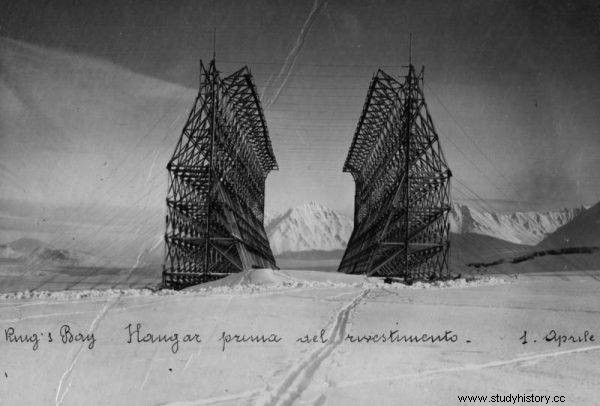
Snow storms raged all around, turning the airship back to base.
Several dozen hours later, the airship reached the base on Spitsbergen. From there, he made several flights, during which he made observations of hitherto unexplored fragments of the Arctic. The main goal of the expedition was, however, difficult to achieve. Snow storms raged all around, turning the airship back to base.
Success with a bitter taste
On May 23, an airship, driven by a strong wind, set off along the coast of Greenland to the North Pole. Twenty minutes after midnight on May 24th, it worked. Italy is right on the Pole. The strong wind, which until now had been a great ally of the crew and was pushing the airship in the right direction, now became their enemy. General Nobile did not manage to lower the flight of the machine, landing turned out to be too risky. So the Italian flag and the oak cross, consecrated by the Pope, were dropped and Italy flew away.
Hurricane wind and snowstorm made the return to the safe base on Spitsbergen protracted. From the morning of May 25, the crew was haunted by bad luck, which seemed not to leave them from the beginning of the expedition. The weather worsened, and it was difficult to keep the icy airship in the air. To make matters worse, the height control lever is jammed. The engines were running at full speed, but the airship, heavy with the ice, was flying at a speed of only 60 km / h.
When it seemed that it would not be worse, Italy hit the ice floe - the gondola shattered and some of the crew (10 people), headed by General Umberto Nobile, fell out . The other six remained aboard the now lighter, engineless hovering airship. Like him, she never found herself again.
Arctic drama
Nine people were left on the unknown and desolate Arctic ice. The tenth body was discovered the day after. Interestingly, the ratler Nobilego came out of the accident without any damage to his health. In the remains of a broken gondola, travelers managed to find crates with food and a damaged radio station, as well as a tent, which they painted red.
After a few attempts, they managed to start the radio and send an SOS signal. It was only on June 3 that the Soviet radio amateur managed to decode the message. Later, it was also picked up by ships from around Spitsbergen. The struggle against time and a great search campaign began, in which units from several countries were involved.
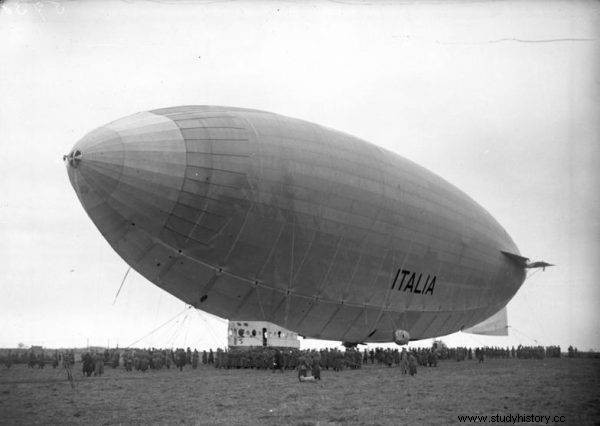
Twenty minutes after midnight on May 24th, it worked. Italy is right on the Pole.
The Norwegian Minister of War also asked for help from Amundsen, who knows the Arctic regions. Despite his sincere hatred for Nobli, the traveler went on a search. He probably wasn't aware that this would be his last trip. On June 18, after less than two hours of flight, his plane went missing, and a few days later, off the coast of the Norwegian city of Tromso, a fragment of the wing and the fuel tank of his machine were found.
To the rescue
It wasn't until June 20 that an Italian plane found the survivors and dumped their food supplies. Three days later, the Swedish pilot managed to land near the camp of the surviving Italian crew. He agreed to take one person on board. The moment when Umberto Nobile boarded the plane with his beloved dog in his arms turned out to be one of the most breakthrough moments in his career.
From now on, he was the commander who chickened out and left his crew at the most terrible moment. To justify him, some public opinion reported serious wounds (broken arm and leg) suffered by Nobile. The Soviet icebreaker "Krasin" saved the remaining survivors after a few more days. The wreckage of Italy with the rest of its crew was never found, it remained in the Arctic ice forever.
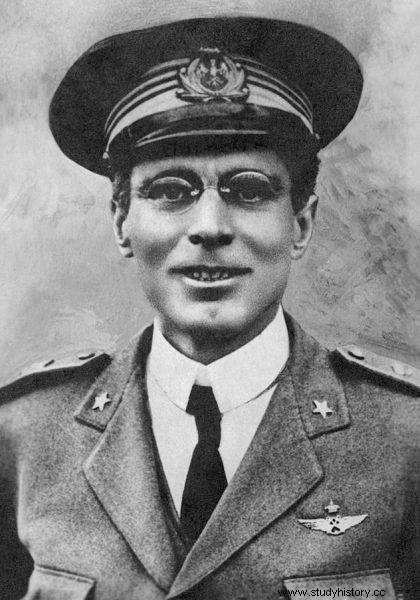
Umberto Nobile (1920s)
Following an investigation in Italy, Nobile was found responsible for the catastrophe and left the Italian army. After the end of World War II, the investigation report into the crash in 1928 was overturned and Nobile was reinstated in the ranks of the military. After the war, Nobile sat in the Italian parliament and lectured at the University of Naples.
In 1969, he unveiled a monument in Tromsø in honor of those who died while searching for the participants of the 1928 expedition. He died on July 30, 1978 in Rome.
Bibliography:
- Umberto Nobile, Red Tent , Warsaw 1976.
- Alfredo Viglieri, 48 days among ice cream , Gdańsk 1939.
- Garth Cameron, Umberto Nobile and the Arctic Search for the Airship Italia , 2017.
- The Editors of Encyclopaedia:Umberto Nobile. In: Encyclopedia Britannica . (eng.)
